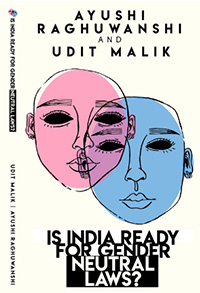BOOK REVIEW
Is India Ready for Gender Neutral Law? by Ayushi Raghuwanshi and Udit Malik, India
Reviewed by Ankit Tiwari (ankitstoryteller@gmail.com), Digital Lawyer, India.
 Is India Ready for Gender Neutral Law?: by Ayushi Raghuwanshi and Udit Malik, India, 2019, 81 pp., ISBN- 978-93-5361-292-4, Rs. 250/-
Is India Ready for Gender Neutral Law?: by Ayushi Raghuwanshi and Udit Malik, India, 2019, 81 pp., ISBN- 978-93-5361-292-4, Rs. 250/-

Jurist of the sociological school of jurisprudence often use the maxim 'Ubisocietas, ibius’ means where there is a society, there is a law. There is strong nexus between law and society as the law is used as a tool for social conflict management. There is no shortage of literature especially books on society and crime which can be utilized as an enduring topic of scholarly inquiry in legal social studies of law. But the value book ‘Is India Ready for Gender Neutral Law?' provides is rare and critical.
In this book, Ayushi Raghuwanshi and Udit Malik critically review gender-specific legislation and examine its validity with current social morality. The book covers the legal as well as sociology side to have an insight into gender neutrality. Each chapter is synchronized with others and together came up with the notion of gender-neutral legislation. The authors make a compelling assessment of the origin of gender disparity, dimensions of patriarchy, constitutional provisions, and existing legislations, with a holistic discussion on present issues and future challenges faced by gender-specific legislation. The chapters in this book provide an insightful, multi-color range of various acts such as the Immoral Traffic Prevention Act, of 19861, Dowry Prohibition Act, 19612, The Protection of Women from Domestic Violence Act 20053 and Sexual Harassment of Women at Workplace (Prevention, Prohibition and Redressal) Act, 20134 through which the need for gender-neutral laws can be addressed.
2. The Dowry Prohibition Act, 1961, Act no. 28, Act of Parliament, 1961(India).
3. The Protection Of Women From Domestic Violence Act, 2005, Act no. 43, Act of Parliament, 2005 (India).
4. THE SEXUAL HARASSMENT OF WOMEN AT WORKPLACE (PREVENTION, PROHIBITION, AND REDRESSAL) ACT, 2013, Act no. 14. Act of Parliament, 2013 (India).
In the introductory chapter, the author initiates discourse by differentiating gender and sex. Chapter future describes gender as a social construct that subsequently leads to social disparities. Due to gender disparity, there is a lot of suffering that each gender faced. In context to women, they have generally been considered a commodity. Their identity is always associated and linked either with their father or husband. This all results in crimes against women like sati, domestic violence, and child marriage. Chapter threw light on moments and incidents which starts addressing crime against women and came up as feminism jurisprudence. The legislature, as well as the judiciary, introduces different enabling provisions by which women's equality can be realized. Especially after the nirbhaya, Delhi rape case reforms are brought through Criminal Amendment Act, 2012 which are women-centric in nature. These reforms, on one hand, enable women also on the other hand limit and ignore the protection of men. Through all these reforms, there are incidents where some women had started misusing provided provisions. The final section of the chapter focuses on the constitution and the rule of law. The gender-specific laws are contrary to the idea of the constitution. As they violate a provision of equality of law and equal protection in law as per Articles 14 and 15 of the Constitution of India. Future goes out of the ambit of various conventions of the United Nations too. Therefore, this chapter suggests that there is a social and legal crisis to having gender-neutral laws in India.
In the next chapter, the authors focus on the origin of gender disparity. It has been mentioned that the position of women was vulnerable from the traditional time. The origin of vulnerability is connected to gender roles where men are designed to do resource collection work and women are expected to do resource management work. As both works are important, still women's work in resource management is considered less valuable. Women's abuse also had nexus with the social belief that the world should be dominated by men. As stated in the first chapter, that woman does not have an independent identity. They have no right to participate also no basic human rights apply to them. The only scope where they are allowed to indulge is house management work which certainly brings large scope for abuse against them. To promote gender equality multiple laws are framed. Women-centric laws aimed to end discrimination against women and to distribute power and equal status to women. The later chapter elaborates on the gradual change through which women's empowerment can be witnessed. For this authors gave the example of numerous women who showed their expertise and leadership in different spheres of the world. Additionally, the author also uses data that shows an increase in the rate of education and employment of women. In the last section of the chapter, it is argued that when women's empowerment took place then side by man suffering also increased. Slowly law forgot to see man as victim and sufferer. The only perception that law has today is the perception of penalizing men for the gender-related crime.
In chapter 3, the authors describe the role of a patriarchal-based society which can be considered a core factor for gender disparity. The authors in this chapter put the major liability on the social structure of patriarchy where due to social morality women suffers. The practice of celebration of male childbirth, exclusive ownership of ancestor property, limitation of participation, and male dominance in family management are all such social practices that are also responsible for women's abuse. The chapter also made religious practice responsible for women suffering. As per religious practice, there is a ritual where men are treated as gods and women as a salve of god. Religious mythologies and stories stereotype a society where the world is shown around men's life. The chapter explains the role of women's empowerment moment from the time of British rule to the present era. In the pre-independence era, the British put ban on numerous social evil practices such as sati pratha, and child marriage. In post-independence, through constitution provisions, women's problems are addressed. Reservation to political inclusion policy and laws drafted. The recent Criminal Law Amendment was also framed with the purpose to develop gender-neutral perceptions for the individual.
In the next chapter, the author discusses constitutional provisions for gender neutrality. First point of discussion in Article 14, Equality before the law which is based on the principle that all persons and things similarly circumstanced should be treated equally. For full-fledge understanding, author explain Sanaboina Satyanarayana v. Government of Andhra Pradesh5 case in which the apex court validates positive discrimination of women in the prisoner. In the second instance, the authors explain Article 15(1) which prohibit the state from discrimination among people and Art 15 (3) enables positive discrimination among citizen. This Chapter also discusses Articles 16 (1) and 16 (3) Constitution of India6 that provides power to the legislature to make laws for enabling equality in opportunity among people. The author also deals with the Directive Principle of State Policy where he specifically discusses Articles 39-A, 42, 46, and 47 all of which obliged the state to make laws specifically for women and other unequal classes and sections of society. Lastly, reservation mentioned under Article 238-D and 243-T for women in local body election is discussed.
6. INDIA CONST. art. 16.
In chapter 5, derivative legislation from the principle of liberty, equality, and justice of the Indian constitution is talked about. This discussed law was initially made for gender-specific purposes but later it became discriminatory in nature. The authors start by explaining the nature and scope of The Immoral Traffic Prevention, Act, of 19567 which is limited to women but does not cover third gender and women for the same offense. Then authors came up with the Dowry Prohibition Act of 19618 (amended in 1986) where the author highlights men's abuse by her wife. The same goes with the Protection of Women from Domestic Violence Act, 20059 which presume men as wrongdoers and women as a sufferer. The authors in the last section deal with the Prevention of Women from Sexual Harassment, Act, 2013, and different provisions of the Indian Penal Code which assume men as crimes and women as a sufferer. Through all these elaboration authors tries to show a limited side of the law while preventing crime and protecting individuals.
8. ibid,2.
9. Ibid,3.
The second last chapter of the book put light on cases where there is a misuse of gender-specific laws. The author came up with the judgment of Sushil Kumar v. Union of India10 where it is mentioned that 'object of the act is to prevent dowry but petitioner rightly contended that there is malice in motive in many complaints. Therefore, in such cases, the acquittal of accuse does not in all the cases wipe out the ignominy suffered during prior of trial.' In Preeti Gupta v. the State of Jharkhand11 case, the apex court observed 'there are many complaints which are false and made only for the ill motive. So, there is high time to update legislation as per social realities.' Through these cases, the author tries to establish that sufferers are both men and women, therefore law should be made accordingly.
11. Preeti Gupta & Anr vs State Of Jharkhand & Anr on 13 August, 2010 (2010) 7 SCC 667, (India).
In the concluding chapter, the authors came up with an analysis of gender-neutral policies which are in practice. For which the notion of gender-neutral application was explained. The idea of gender neutrality can be achieved through the social-economic setup and by curbing gender disparities. Social Economic setup refers to the freedom which women should get in choosing education and employment. Also, the workplace should be established from a gender-neutral point of view where equal opportunities should be provided to women, men, and the third gender.
This book covers a wide range of arguments that highlights the origin, limitation, and way forward for gender-specific law. The authors have well researched the legislation and precedents through which strong claims can be made for the issue. A somewhat deeper engagement and analysis or critique of gender disparity and compliance with social practice can be seen. Authors also have successfully addressed the need of society through historical readings. The only limitation of the book is that it does not discuss present gender-neutral policies. This book can be utilized by scholars, students, academicians and policy makers in their studies.
- FIR Copy of Mahatma Gandhi assasination case
- Licito Concurso'20
- Rules for Licito Concurso '20- A National Legislative Drafting Competition
- Registration Form for Licito Concurso-20
- www.apexcourtweekly.substack.com
- www.lawupdater.com/wp/
- XIIIth K.K. Luthra Memorial Moot Court Competition 2017
- President of India Presented with the First Copy of the Book Statement of Indian Law Published by Thomson Reuters





